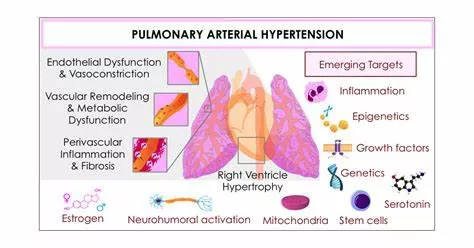Idiopathic pulmonary arterial hypertension (IPAH) is a rare but serious condition that affects the blood vessels in the lungs.
It is characterized by high blood pressure in the pulmonary arteries, which are the blood vessels that carry blood from the heart to the lungs for oxygenation. IPAH is considered idiopathic because its exact cause is unknown, making it a challenging condition to diagnose and treat effectively.
What Is Idiopathic Pulmonary Arterial Hypertension?
IPAH is classified as a subtype of pulmonary arterial hypertension (PAH), which is a broader category of diseases that affect the pulmonary arteries. PAH is characterized by the narrowing and stiffening of the pulmonary arteries, leading to increased resistance to blood flow and elevated blood pressure in the lungs. In the case of IPAH, the condition occurs without an identifiable underlying cause such as lung disease, heart defects, or other medical conditions.
see also: What Causes High Levels of CO2 in Blood?
Epidemiology
IPAH is relatively rare, with an estimated prevalence of 10 to 52 cases per million adults. It can occur at any age but is most commonly diagnosed in adults between the ages of 20 and 60. Women are more likely to develop IPAH than men, with a female-to-male ratio of approximately 2:1.
Symptoms
The symptoms of IPAH can vary widely but often include:
Shortness of breath, especially during physical activity
Fatigue and weakness
Chest pain or discomfort
Fainting or dizziness
Swelling in the ankles and legs (edema)
Bluish lips and skin due to decreased oxygen levels in the blood (cyanosis)
Diagnosis
Diagnosing IPAH requires a thorough medical evaluation, including:
Medical history and physical examination
Blood tests to assess oxygen levels, liver function, and other markers of heart and lung health
Imaging tests such as echocardiography, chest X-rays, and CT scans to evaluate the structure and function of the heart and lungs
Pulmonary function tests to assess lung function and capacity
Right heart catheterization, which involves inserting a catheter into the pulmonary arteries to measure blood pressure and oxygen levels directly
Treatment
The goals of treating IPAH are to reduce symptoms, improve quality of life, and slow disease progression. Treatment options may include:
Medications: Several classes of drugs are used to manage IPAH, including vasodilators, endothelin receptor antagonists, and prostacyclin analogs. These medications help to relax blood vessels, reduce blood pressure, and improve blood flow in the lungs.
Oxygen therapy: Supplemental oxygen may be prescribed to improve oxygen levels in the blood and alleviate symptoms of hypoxia (low oxygen levels).
Lifestyle modifications: Patients with IPAH are encouraged to maintain a healthy lifestyle, including regular exercise, a balanced diet, smoking cessation, and managing comorbidities such as obesity and sleep apnea.
Surgical procedures: In some cases, surgical interventions such as pulmonary thromboendarterectomy (removal of blood clots from the pulmonary arteries) or lung transplantation may be considered for severe or refractory cases of IPAH.
Prognosis
The prognosis for patients with IPAH can vary depending on factors such as age, disease severity, response to treatment, and the presence of complications. With early diagnosis and appropriate management, many patients can experience improved quality of life and long-term survival. However, IPAH is a progressive disease, and close monitoring by a multidisciplinary team of healthcare providers is essential for optimal outcomes.
Conclusion
Idiopathic pulmonary arterial hypertension is a complex and challenging condition that requires a comprehensive approach to diagnosis and management. With advances in medical therapies and supportive care, the outlook for patients with IPAH has improved significantly in recent years. However, ongoing research is needed to better understand the underlying mechanisms of the disease and develop more effective treatments for this rare but serious condition.
FAQs
What is the cause of idiopathic pulmonary arterial hypertension?
The exact cause of idiopathic pulmonary arterial hypertension (IPAH) is unknown, hence the term “idiopathic.” However, researchers believe that a combination of genetic, environmental, and possibly immune system factors may play a role in its development. Some studies suggest that certain genetic mutations or variations in genes related to the regulation of blood vessel function and growth may contribute to the development of IPAH. Environmental factors such as exposure to toxins, infectious agents, or other triggers may also play a role in susceptible individuals. However, further research is needed to fully understand the underlying cause of IPAH.
Which is a characteristic of idiopathic pulmonary arterial hypertension?
Idiopathic pulmonary arterial hypertension (IPAH) is characterized by high blood pressure in the pulmonary arteries, which are the blood vessels that carry blood from the heart to the lungs for oxygenation. This elevated pressure in the pulmonary arteries leads to increased resistance to blood flow in the lungs, which can result in symptoms such as shortness of breath, fatigue, chest pain, fainting, swelling in the legs, and bluish discoloration of the lips and skin due to decreased oxygen levels in the blood (cyanosis). IPAH is classified as a subtype of pulmonary arterial hypertension (PAH) and is diagnosed when there is no identifiable underlying cause for the condition.
Can I live a long life with pulmonary hypertension?
The prognosis for individuals with pulmonary hypertension (PH) depends on various factors, including the underlying cause of PH, the severity of the condition, the response to treatment, and the presence of complications. While PH can be a serious and progressive condition, many individuals can live a long and fulfilling life with appropriate medical management and lifestyle modifications. Early diagnosis, prompt initiation of treatment, regular follow-up with healthcare providers, adherence to prescribed medications, maintaining a healthy lifestyle (including regular exercise, balanced diet, and smoking cessation), and managing comorbidities are essential for improving outcomes and quality of life for individuals with PH.

